Celosia comb: description, reproduction, cultivation and application
Celosia crista is a beautiful plant that has become very popular with all flower lovers. Unusual and bright appearance, aesthetics and showiness, with persistence and unpretentiousness for cultivation, are captivating qualities. It is curious that this flower is even sung in Japanese poetry, famous for its grace.
Content:
- Description of cellosis comb
- Reproduction and cultivation of a plant
- Characteristics of Celosia comb
- Plant diseases
- Plant application
Description of cellosis comb
Scientists rank this plant as to the family of Celosia (Celosia), amaranth family. Celosia is a Latin word that appears to be derived from the Greek Kelos, meaning fiery or flaming. The name of the plant is immediately clear at the first glance at the flower and the bright, rich palette of its color.
In the modern world, there are about 60 species of these herbaceous plants, the natural habitat of which is the tropics.
The geography is as follows:
- Asia,
- Africa,
- South America.
According to its shape, the flower is classified into the following types:
- Spikelets
- Cirrus
- Comb-shaped.
Celosia comb and Celosia pinnate are unconditional leaders among people in popularity for their breeding (cultivation). Let's talk about the first of them today.
Its full name is Celosia argentea f. Cristata, that is, silvery comb. Or, if you like, a cockscomb, as mentioned above, since the flowers are outwardly similar to it.
This plant is perennial, although it is cultivated for practical reasons precisely as annual.
The height of the celosia in natural nature usually does not exceed 45 cm, for gardeners, handsome bushes are more compact -20-35 cm.The appearance of the comb celosia, which dictated the name of the plant, is exactly this: small flowers are buds of inflorescences, the upper edge of which is winding, causing associations with a crest rooster.
Celosia has a bright color palette: blood red, orange, yellow, pink colors and their shades.
A rare combination of brightness and specific shape of flowers distinguish cetacean crested against the background of other representatives of the terrestrial flora.
Reproduction and growing of a plant
With its outward exoticism and unusualness, one is even surprised at how unpretentious our "cockerel" is in terms of its breeding.
You can propagate celosia in different ways:
But in the practice of cultivating a plant, the first method predominates, since it preserves the selection ("pedigree") of plants better.
Again, experienced florists recommend sowing a balcony or garden with seeds of various varieties of celosia, and then it will bloom for a long time all warm seasons (in summer and in the first half of autumn).
In our conditions, plant seedlings are prepared in greenhouses in early spring, sown in March.
Technological features of flower cultivation:
- Sow seeds in moist soil not often, so that future seedlings are spaced 5 cm apart from each other.
- It is best to sow celosia initially each seedling in its own pot, so you will avoid the danger of damaging the root system in the event of a transplant.
- After 5 days (plus or minus), the sprouts of the future pride of the garden will appear.
- The climatic temperature for seedlings is 17-20 degrees Celsius, that is, room temperature, with good light and air circulation.
- You need to water, as they say, with sense and arrangement.
- Avoid extremes - feed your seedlings sparingly and carefully, without drying out the soil or turning it into a swamp, as in excessively damp soil, the roots of young plants will rot.
- Sunlight is necessary, but it is not necessary for the direct hot rays to "roast" the seedlings.
As you remember, celosia comes from the tropics, so do not try to start transplanting it into open ground until the warm weather is over and the threat of frost has passed.
Plant seedlings like this: if it is a dwarf variety, there are 10-15 cm distances between seedlings, ordinary ones - 20-30 cm.
In the garden, a sunny and, if possible, protected from gusts of wind side is well suited for cellosis.
Soil requirements:
- The ideal option is not dense and slightly acidic in terms of chemical composition. Desirable good drainage.
- The monthly application of fertilizers (mineral) will have a beneficial effect on the splendor of the flowers. Organic - per code before boarding.
- "Cockerel" is hygrophilous, therefore, when it is hot and when there is no rain, you need to water the plants well, otherwise they wither and no longer bloom.
Reproduction of cellosis is not difficult.
Characteristics of Celosia comb
First of all, celosia is simply amazingly beautiful plants.
Celosia with its exotic velvety-fluffy inflorescences is perfectly combined with the general landscape of the land, looks good in any flower compositions, giving the gardens a unique flavor.
Potted plants with their simply amazing beauty are a bright touch of the interior of an apartment, a cheerful decoration of its loggia or balcony.
These flowers are widely used in floristry, as they are able to maintain their "model" shape for a long time.
In addition to the aesthetic, decorative value, this plant is endowed with a number of practical qualities useful to humans:
- Immediately, we note that celosia is not only not poisonous, like some of her "classmates" - curbs and houseplants, but, on the contrary, the inhabitants of its natural habitat (countries of the tropical belt) use it with pleasure in their cooking: they put the leaves of celosia in soups and salads, or even used in dishes as a side dish. In addition, they are excellent food for livestock.
- From ancient celosia, it has also found application in folk medicine... It is good for restoring immunity, fighting worms and inflammatory processes, effectively treating blood and vision diseases.
Here are some of the most widely known recipes for infusion of celosia, recommended for use:
- Recipe for gastric and intestinal disorders: chop cellosia leaves and stir in an amount of 2 salt spoons in a glass of water with 1 teaspoon of flower honey. The leaves are poured over with hot water and allowed to stand for at least an hour before mixing with tea. Dosage - 50 ml of infusion 3 times a day. It can also be used for worms, including colds.
- Recipe for inflammation of the oral cavity: squeeze the juice from a handful of leaves and pour a glass of warm water. Rinse 3-5 times a day: with sore throat - throat, with stomatitis - mouth.
The famous celosium oil is obtained from the seeds of this plant.
As you can see, this plant can be used in different qualities. But even if these flowers are just a photogenic model for you, you will already have a lot of pleasure.
Plant diseases
Like everything in nature, our "comb friend" is very vulnerable to all sorts of misfortunes.
Let's take a closer look at all the threats to integrity:
- Very often the plant is affected by fungi of the genus Botrytis. This fungal disease is called "black leg". Each piece of land is potentially dangerous in this regard, so the soil must be specially treated before planting the cellosis.If traces of the disease are detected, immediately destroy the affected seedlings without leaving any residue, since the "black leg" is infectious. The soil in this place also needs to be disinfected. It is noteworthy that the disease "mows" both garden plants and indoor plants.
- Symptoms are as follows: the stem turns black at the base, the fungus enters the plant and clogs blood vessels, stopping the free flow of juice. As a result - yellowing of flowers and sagging, drying out of the root system, and, in the end, the death of the culture.
-
As a rule, cellosia is affected by this disease in "adolescence" (traces are seen even in seedlings).
- Recommendations: avoid the accumulation of moisture on the soil (puddles), do not plant in excessively acidic and slightly loose soil with poor drainage, maintain temperature requirements (do not get carried away with the "greenhouse" covering of seedlings, in particular), sowing, feeding, ventilation (indoor plants).
- Remember that the disease described above is spread by soil, plant debris and insects.
- As a preventive measure, the seeds should be treated with a manganese solution, which can also be used to water the soil in the future.
- Treatment: after revealing signs of the disease - loosen the soil and sprinkle it with charcoal ash or lime. You can also sprinkle the ground with soda solution or onion peel tincture.
- If detected at an early stage and when not the entire array of plant culture is infected, remove the spoiled and weak specimens, and then water less than before.
- Aphids are another natural enemy of the cockerel. To combat it, celosia is sprayed with an appropriate preparation (insecticide).
Ferrous preparations are used when celosia is treated to protect against chlorosis. So, if this "cockerel" is dear to you, take care of it by taking elementary precautions.
Plant application
Celosia comb is ideal plant for a garden bed and in general a garden plot. She will delight with the madness of colors from her very first shoots and until the end of flowering you will not want to part with her.
Celosia comb blooms from July to October - a quarter of a year!
Its scallops are very fluffy, velvety, one might even say velor. And how saturated the color shades are! With all this, there are no difficulties with growing.
Cut flowers will last more than a week without changing the water.
The decorative effect of plants does not go away even after their flowering - celosia leaves are not only green, but also, in imitation of their colors, golden and red (there are a lot of shades).
Another remarkable quality is that flowers, cut before the seeds ripen, and well dried without light in a cool room, do not lose their shape and color, and therefore are ideal as material for floral ensembles (ikebana).
Therefore, a flowerbed with a comb-shaped plant invariably attracts admiring glances.
More information can be found in the video.



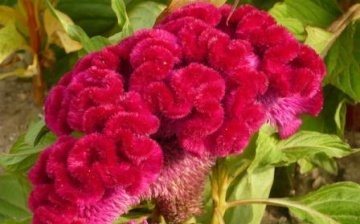
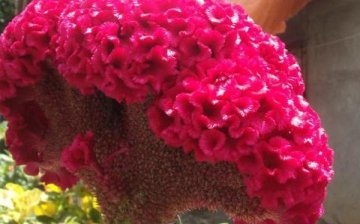

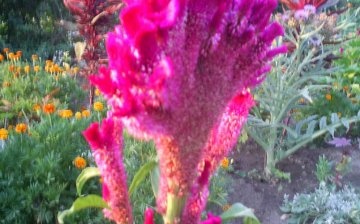
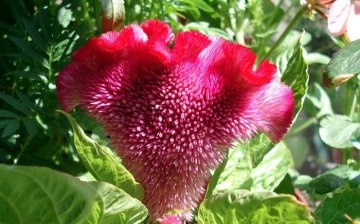








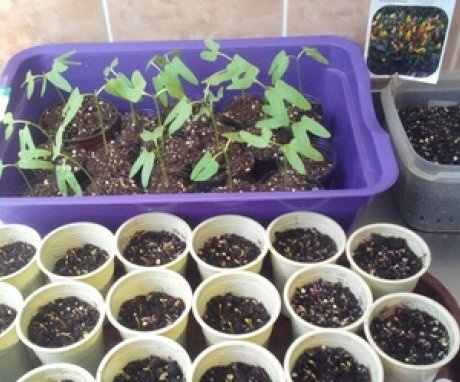

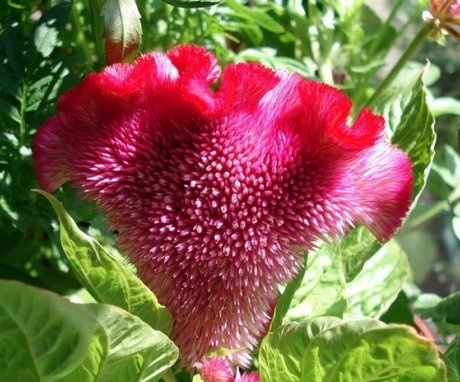

Yes, the flower is just great. True, he is quite whimsical. But you need to learn to "feel" it, and then there will be no problems with cultivation.
What an amazing flowering plant! I once saw this in the picture, but I thought it was just invented, but it turns out that there is such a handsome man in fact.